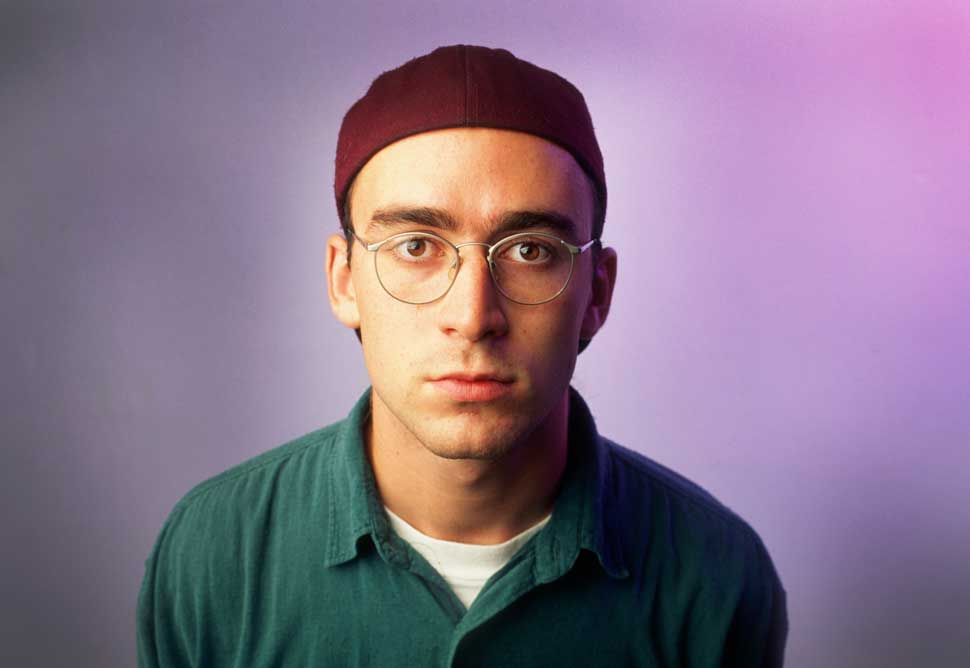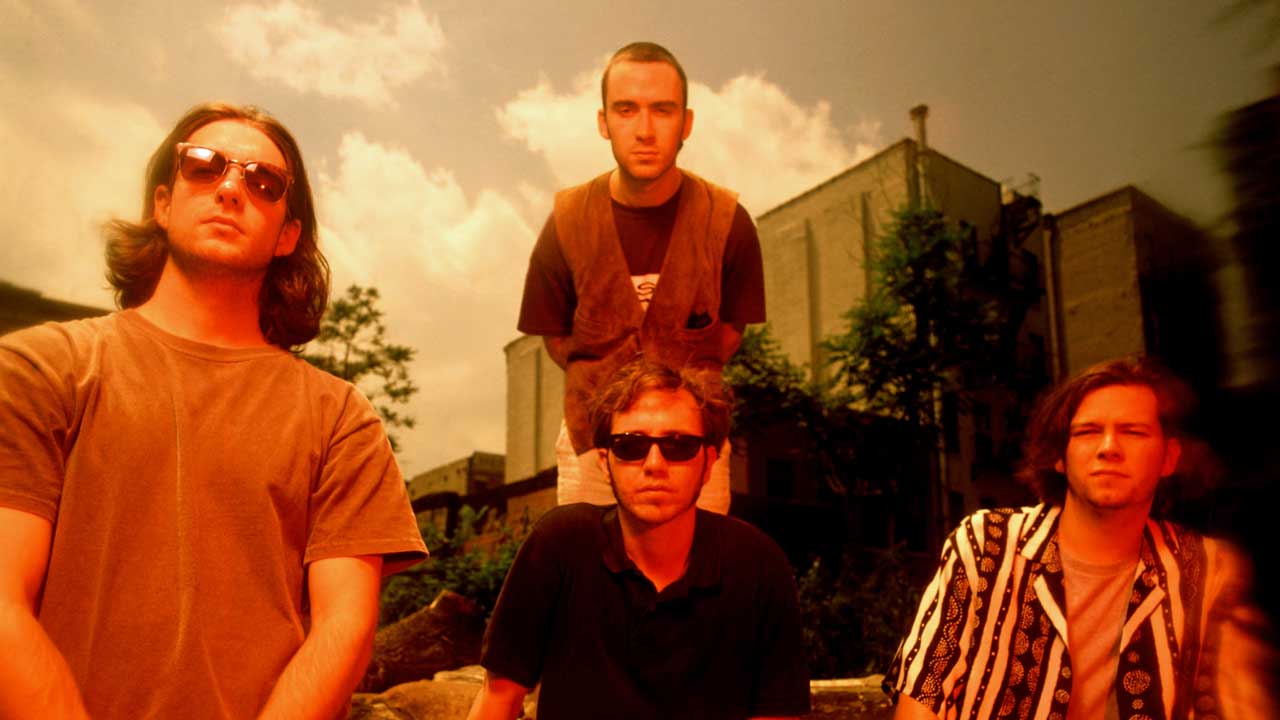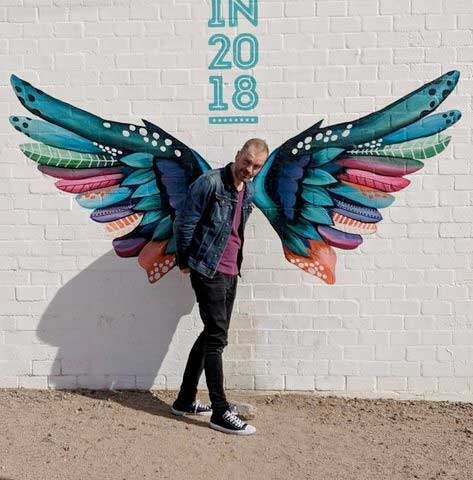Live's Throwing Copper was released 30 years ago, on April 26, 1994. It became a US #1 and sold more than 8 million copies in the US alone, but the band struggled with the ensuing success and split after frontman Ed Kowalczyk left in 2010. Six years later they reunited, and Kowalczyk told us the story of Live's rise and breakthrough.
Ed Kowalczyk was stuck in traffic when the scale of his success hit him. It was July 1995, and Live’s singer was trying to get to a gig at the Hersheypark Stadium in Hershey Park, South Pennsylvania, only to be thwarted by 30,000 other people trying to get to the gig. The snag was that it was Kowalczyk’s own band who were due on stage that day, and this homecoming show was supposed to be their crowning glory.
“There was this moment where we were sitting on top of this hill, and I could see about two or three miles ahead of me across the valley, and we were literally stuck behind all the fans trying to get to the show,” he says. “That’s when it sunk in. I thought: ‘This is crazy. Look at all these people. I can’t get to my own concert.’” He laughs. “I was in the traffic thinking, ‘Was someone supposed to send an escort or something?’”
Kowalczyk and Live eventually made the stage, albeit late. But they were used to long delays. Their second album, the electrifying Throwing Copper, had reached No.1 in April 1995, a year after its release.
Amid the seismic musical and cultural upheavals of the early 90s, Throwing Copper was a kind of beacon. It rode the alt.rock wave, but rejected the drug-fuelled nihilism and weaponised irony of grunge in favour of deeply rooted spirituality and relentless self-questioning that owed more to U2 and R.E.M. than it did to Nirvana or Soundgarden. In Kowalczyk they had a singer who wore his early-90s earnestness as a badge of honour.
“We took our own road,” he says now. “We were this band from a small town in Pennsylvania with big guitars that pushed into this universal, spiritual place that wasn’t necessarily safe ground for a rock’n’roll band. That took courage.”

Live’s own career wasn’t quite stuck in a traffic jam, but it took a long time to arrive at its destination. The journey started in the “cultural vacuum” (Kowalczyk’s words) of York, Pennsylvania back in the early 80s, when the singer, guitarist Chad Taylor, bassist Pat Dahlheimer and drummer Chad Gracey put together their first band, Action Front. Dahlheimer’s older brother was their musical compass, introducing them to the world of alternative rock years before it merged with the mainstream.
“He said: ‘If you want to form a band, these are the groups you should be listening to: The Cure, R.E.M., U2, The Smiths,’” says Kowalczyk. “We just buried our noses into those bands. Those were the days before they were household names.”
The precocious quartet had barely entered their teens when they recorded their first demo tape, featuring covers of songs by the first three of those four bands. It would be several years and countless name changes (discarded monikers: Body Odor Boys, Paisley Brues, Club Fungus) before they settled on Live and released their debut, 1991’s Mental Jewelry.
The long slog that had got them to that point paid off. Mental Jewelry was the work of a band who were already fully formed. On songs such as Pain Lies On The Riverside and Operation Spirit (The Tyranny Of Tradition), Live came on like a patchouli-doused R.E.M. As the titles suggests, Kowalczyk’s lyrics came from a thoughtful place – the singer was a student of the works of Indian philosopher Jiddu Krishnamurti, who espoused the notion of personal humility and selflessness.
“It was just a straightforward questioning of everything – the traditions you grew up in, automatic things that you just take for granted,” he says. “There were a lot of light-bulb moments, one after the other.”
Live’s against-the-grain approach was striking enough to get them traction on college radio and MTV. “It was more successful than we ever thought it would be,” says Kowalczyk. But by the time it came to record a follow-up album, they were restless for change.
“I remember coming home from that tour and thinking, ‘Okay, so what now?’” he says. “One thing was that we wanted to make things more dynamic. We were really into that chinky-chinky rhythmic guitar thing, but I was thinking about how we could sell things even more emotionally. And you need big guitars for that. So we plugged in.”
In July 1993 the band holed up in Pachyderm Studios in rural Minnesota to write and record their second album. The studio had a fine pedigree: Soul Asylum, The Jayhawks and, most notably, Nirvana had recorded key albums there. More importantly, it was tucked away in the woods, far from any potential distractions – useful for Live, whose ambition wasn’t matched by their budget.
“Our record company was pretty stingy, and I think we could afford maybe two weeks,” Kowalczyk says with a laugh. “Which in hindsight was probably good. It was throw-and-go, make it as good as you can in the little time you have, without the luxury of all the technology we have now.”
Overseeing the sessions was producer Jerry Harrison, formerly guitarist with New York art-punk visionaries Talking Heads. Harrison passed on to Live his own experience of being in a group who habitually broke the rules.
“We didn’t know how to make records. We didn’t know the songs could be six-and-a-half minutes long,” says Kowalczyk. “Jerry was a real mentor in that sense. And he was a real intellectual guy. Me and him would have these really deep conversations about spirituality and philosophy. He was really into the lyrics I was writing. He really inspired me in a lot of ways.”
The band worked fast, building songs from the ground up. Their steely new musical MO was evident in new songs such as I Alone, Selling The Drama and Lightning Crashes – songs that chimed with the prevailing trends of grunge and alternative rock but possessed an oblique philosophical depth most of their early 90s peers steered clear of. Now, as then, Kowalczyk prefers his lyrics to remain open to interpretation, though lines such as ‘And to Christ, a cross, and to me, a chair/I will sit and earn the ransom from up here’ (from Selling The Drama) were a world away from Are You Going To Go My Way?.
“Those ideas came to me really easy,” says Kowalczyk. “You’re a fledgling songwriter and lyricist, and you’re not sure if you’re very good at it, and then out comes this energy that’s encapsulated in those songs.”
April 1994 was barely under way when Kurt Cobain committed suicide. Throwing Copper was released just two weeks after Cobain’s death. Its spiritual intensity and existential questioning seemed to simultaneously reflect and salve the mix of grief and confusion that followed. Even the striking cover – a painting by Scottish artist Peter Howson of a figure clutching a bible on the edge of a cliff – only added to the mystique.
“That was an emotional period of time for music,” says Kowalczyk. “And as a writer, it was an emotional time to be participating in it in your own way.”
Throwing Copper sold steadily, building a head of steam rather than blazing out of the traps. The singles Selling The Drama and I Alone were picked up by MTV. At some point between the two Kowalczyk shaved his head, leaving just a rat’s tail of hair; in the I Alone video he looked more like a devotee of some obscure Eastern religion than a rock singer. His performance screamed: ‘I am seriously intense’.
“Oh, we were very serious young men,” he says now, laughing. “Maybe not too serious. But close.”
That September, Live were invited to play Woodstock ’94, a 25th-anniversary update of the famed hippie-era festival. Today the line-up looks like a time capsule of the Clinton era: Blind Melon, Nine Inch Nails, Green Day, Candlebox and Collective Soul. Still, it put Live in front of 250,000 pairs of eyes on the day – and tens of millions more on TV.
“The way I experienced it was such a blur,” says Kowalczyk. “We rode up there, they spun the stage around and we’re standing in front of a quarter of a million people. It was overwhelming; we kicked into a kind of adrenalin survival mode. We rocked out the set, spun back around, we were off. That fast. It was crazy.”
Woodstock dovetailed with the song that would give Throwing Copper the extra push it needed. Released at the end of September 1994, Lightning Crashes was Live boiled down to their essence: an alt.rock power ballad that attempted to square the circle of life from birth to death, complete with vivid images of childbirth (‘the placenta falls to the floor’) and a memorably arty video. At five and a half minutes – the first two of which were completely free of drums – it was one of the more unlikely hits of the decade.
“I went into it with this idea that I just wanted to tell a story,” says Kowalczyk. “I wasn’t sure what the story was going to be, but it started with: ‘Well, why not just begin with a birth?’ It became this celebratory song about life in a really deep way, without being cheesy. You look back and go: ‘Would I ever get a five-and-a-half minute song on the radio in America today?’ I doubt it.”
The place that Lightning Crashes occupies in the cultural landscape of 90s America was sealed in the bitterest way imaginable. On April 19, 1995, white supremacist Timothy McVeigh detonated a car bomb outside a federal building in Oklahoma City, killing 168 people – at the time the biggest terrorist atrocity on US soil since Pearl Harbor.
In the days that followed, an Oklahoma radio station began to air a version of Lightning Crashes that mixed the original song with samples from news reports that emerged after the tragedy.
“It kind of became the adopted song for the bombing,” says Kowalczyk. “People used it to mourn to. It soundtracked a part of history.”
The song’s raised profile in the wake of the Oklahoma bombing helped propel Throwing Copper to No.1 on the Billboard chart in early May 1995, a year to the week after the album was released.
As Live’s profile grew, so did the scrutiny the band found themselves under. “On stage, this intently mediocre young band is U2 without a guitar sound,” wrote venerated American music journalist Robert Christgau sneeringly. “On record, it’s R.E.M. without songs.” Much of the criticism centred on Kowalczyk’s undiluted intensity.
“I definitely had moments where people weren’t so nice,” he says. “But in the end, the balance was always to the good. People would say: ‘We want to hear what you’re going to do next.’”

What happened next was a textbook 90s move: a band reacting against its success. Live followed Throwing Copper with 1996’s Secret Samadhi, a darker, murkier proposition. Kowalczyk’s lyrics became more oblique: ‘Let’s go hang out in a mall or a morgue/A smorgasbord’, ran the opening line of the album’s first track, Rattlesnake.
“I always admired the way R.E.M. never duplicated what they did before – there was always this sense of, ‘If you just recreate what you did, it’s cheesy and stupid’,” he says. “There was a bit of that – a rebellion against our success: what would a punk band do? The record company were going, ‘What the…?!’ We just stuck to our guns.”
Secret Samadhi sold decently, as did all successive albums, but none matched the huge success of Throwing Copper. Like Stone Temple Pilots’ first two albums and Bush’s Sixteen Stone, it remains an album of the people rather than the critics.
Then in 2010 something strange happened. Live’s well-cultivated air of placidity was shattered when Kowalczyk unexpectedly left the band. A supposed two-year hiatus became a permanent split after Taylor, Dahlheimer and Gracey sued the singer for breach of contract. Lawsuits and counter-lawsuits were filed. Kowalczyk was replaced by Christopher Shinn; Kowalczyk embarked on a solo career. “There was some ugliness,” he says with dry understatement.

If that was a shock, then the two parties’ out-of-the-blue reconciliation in 2016 was an even bigger one. Or maybe it wasn’t – this was a band who had literally grown up together, after all.
“Basically, we missed each other,” says Kowalczyk, “the uniqueness of what we do together, combined with the incredible history we have with each other.”
Two years on, that split looks like nothing more than a bump in the long road that took Live out of smalltown America and brought them to the place they find themselves today.
“We came from York, Pennsylvania, and there was this eagerness to break out,” he says. “And you can really hear it in the record and see it in the videos. And we weren’t alone. There was such a community of bands at festivals that also had this thought of, ‘Let’s do something different, let’s be ourselves.’ There were so many authentically original voices during that period.”
Someone recently asked Kowalczyk if he could talk to the guy in the I Alone video, what would he say? He laughs at the thought.
“I’d tell him to relax,” he says. “Everything’s going to be okay.”
This feature originally appeared in Classic Rock 247, published in April 2018. The reformed Live released two digital singles and an EP later that year, but Chad Taylor, Pat Dahlheimer and Chad Gracey left the band in acrimonious circumstances in 2022. Kowalczyk is now on tour with a new Live lineup.

